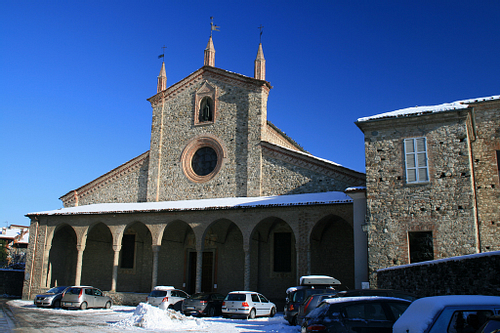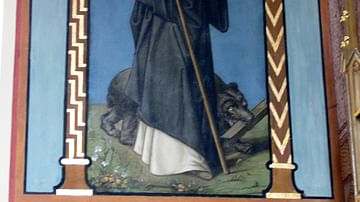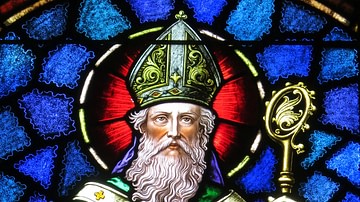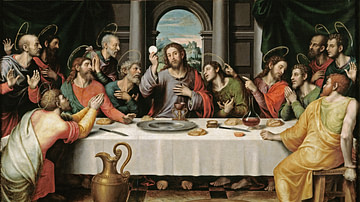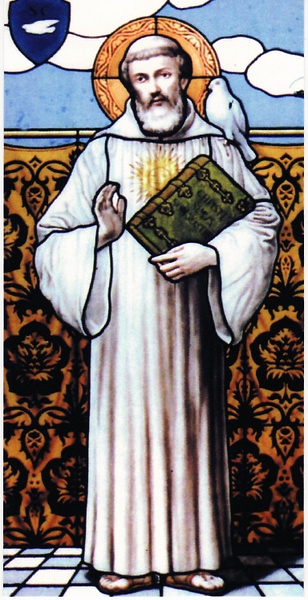
Saint Columbanus or “Columbán” (543-615 CE) was one of the greatest missionaries of the early Catholic Church who led the “Hiberno-Scottish mission” of conversion across much of what is now Western Europe in the late 6th and early 7th century CE. Although chiefly remembered as the founder of Bobbio Abbey in present-day Italy c. 612-614 CE, St. Columbanus also founded Luxeuil Abbey in present-day France. Columbanus was additionally a poet, writer, and scholar. He remains venerated in both the Catholic Church and Eastern Orthodox Church, and is the Patron Saint of Motorcyclists. His feast day is on November 23 in Ireland and November 24 for Benedictines.
Early Life & Origins
Much of what we know about the life of St. Columbanus comes from an account of his life written by Jonas of Bobbio (c. 599-659? CE) an Italian monk who lived in the decades immediately following Columbanus' death. Columbanus was a native of Leinster, Ireland, and he was first educated under Abbot Sinell of Cluaninis, whose monastery was on an island of the River Erne, in modern County Fermanagh. St. Columbanus later elected to study at the monastery of Bangor in County Down, in what is now Northern Ireland. At Bangor, Columbanus received a comprehensive education, including Greek and Latin, under the tutelage of St. Comgall (c. 510-602 CE) who was the Abbot of Bangor Monastery. Despite being a very handsome man, Columbanus was serious in temperament and was noted for his love of scholasticism, debate, and learning. He reportedly thrived under the strict discipline enforced by St. Comgall at the monastery of Bangor, and this colored his personal habits for the rest of his life.
Mission & Travels in Western Europe
Around c. 590 CE, St. Columbanus traveled from Ireland through Britain to Merovingian France with 12 companions. Arguably, the most famous of his 12 companions was Saint Gall, who subsequently founded the city and monastery of Saint Gallen in what is present-day Switzerland, but St. Columbanus the Younger, St. Attala (d. 622 CE), and St. Deicolus (c. 530-624 CE) also accompanied St. Columbanus on his mission to the Continent. After arriving at St. Malo in Brittany, St. Columbanus and his companions proceeded to Reims, which was the Merovingian capital. St. Columbanus and his companions later left Reims, stopping for extended periods of time in Luxeuil, Nantes, and Annegray near the Vosges Mountains. At Luxeuil, St. Columbanus founded Luxeuil Abbey, and elsewhere in Burgundy, he founded Annegray Abbey and Fontaines Abbey.
St. Columbanus initially cultivated warm relations with the Merovingian royal family, and St. Guntram of Burgundy (c. 532-593 CE) was a steadfast friend. Under royal patronage, Columbanus and his companions attained and exerted great influence in ecclesiastical matters across Merovingian France. This tremendous influence coupled with St. Columbanus' exhortations about the moral laxity of the Merovingian court and Frankish bishops, caused the ire and resentment of many nobles and bishops alike. Tensions arose in 603 CE when St. Columbanus and his followers argued with Frankish bishops over the exact date of Easter. (St. Columbanus celebrated Easter according to Celtic rites and the Celtic Christian calendar.) St. Columbanus was banished from Merovingian France following a disagreement with Queen Brunhilda of Austrasia (c. 543-613 CE) around c. 610 CE on the topic of the degenerate morals of her children. A powerful and efficient ruler while regent for her son, grandson, and great-grandson, Brunhilda was quite interested in Church affairs too, which brought her into direct conflict with Columbanus, her in-laws, members of the Merovingian nobility, and several Catholic bishops. She feared Columbanus' influence in Austrasia would circumscribe her own influence in ecclesial matters, hence why Columbanus was exiled from Merovingian France.
Columbanus, Saint Gall, and the other companions traveled down the Rivers Moselle, Vosges, Rhine, Aar, and Limmat to Lake Zürich. Near the banks of Lake Zürich, Gall and Columbanus attempted to establish a mission for evangelization of the nearby Alemanni tribes and Romansh-speakers in what is present-day Tuggen, Switzerland, but they failed to win converts. Instead, their efforts incurred a wave of persecution and they subsequently had to move onward towards the safety of Bregenz. Columbanus separated from St. Gall at this time, continuing a journey of his own over the Alps to Italy.
Bobbio Abbey & Legacy
King Agilulf (r. 591-616 CE) and Queen Theodelinda (c. 570-628 CE) of Lombardy welcomed St. Columbanus and his much smaller party of monks to Italy in c. 611 CE. It is believed that St. Columbanus and his companions spent time in Milan between c. 612-613 CE, meeting various Lombard dignitaries and elites. St. Columbanus, however, once again found himself involved in ecclesiastical controversies - this time in the “Arian controversy” - but Agiluf was less bothered by their differences in religious viewpoints. (Theodelinda, herself, favored Nicene Christianity and the doctrines of Rome). Agiluf granted St. Columbanus a new monastery in 614 CE, which is located some 118 km (73 miles) to the south of Milan in the foothills of the Apennines along the River Trebbia at Bobbio.
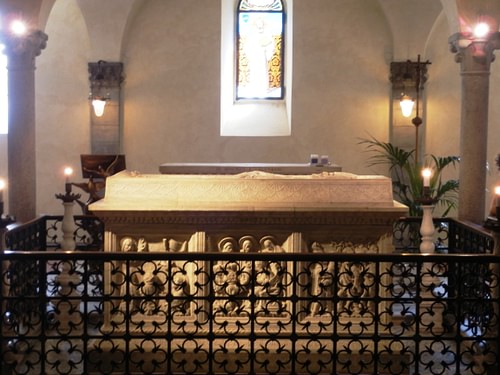
St. Columbanus died in 615 CE, but his legacy endured at Luxeuil Abbey as well as Bobbio Abbey, the latter of which became a renowned center of learning in the Early Middle Ages. (Bobbio Abbey became so famous that it rivaled the monastic community at Monte Cassino in wealth and prestige.) St. Attala continued St. Columbanus' work at Bobbio, proselytizing and collecting religious texts for the abbey's library. In recent years, Pope Benedict XVI (r. 2005-2013 CE) expressed his opinion that St. Columbanus could be called "a European saint" due to his work across Western Europe. Benedict XVI noted that St. Columbanus used the expression totius Europae or "of all Europe" in Latin within a letter written to Pope Gregory the Great (r. 590-604 CE) in c. 600 CE. In his native Ireland, St. Columbanus is remembered chiefly as one of the first to express his Irish identity in writing. In a letter St. Columbanus wrote to Pope Boniface IV (r. 608–615 CE) in 613 CE, he employed the words “...we Irish.”
